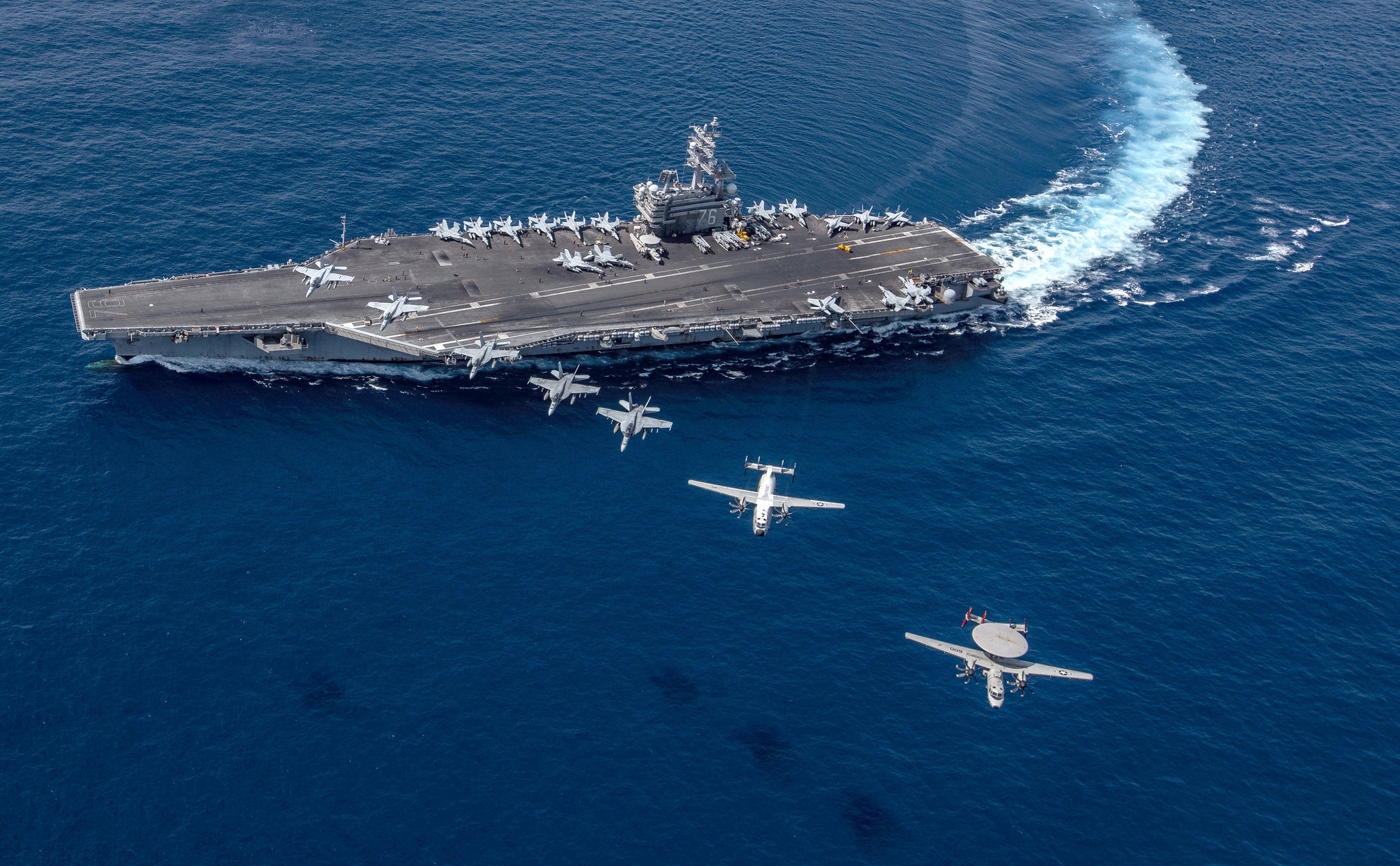How U.S. Spy Flights Against China Undermine the International Order
Recent incidents in the South China Sea have called into question whether some U.S. spy flights in international airspace violate international norms.

Published by The Lawfare Institute
in Cooperation With

Recent incidents in the South China Sea have called into question whether some U.S. spy flights in international airspace violate international norms. According to a Chinese think tank, in early September, while lingering in international airspace between China’s Hainan Island and the disputed Paracel Islands, a U.S. Air Force aircraft used electronic identification codes assigned to a Malaysian civilian plane. Again, on Sept. 22, another U.S. aircraft flying over the Yellow Sea used a transponder code assigned to a Philippines commercial airliner. According to a Chinese government spokesperson, this is a common practice. The U.S. has neither confirmed nor denied the practice. However, the head of U.S. Pacific Air Forces, Gen. Kenneth Wilsbach said, “I know we follow the rules for international airspace and we were following the rules that day.” Nevertheless, Philippines National Security Adviser Hermogenes Esperon Jr. said the incident could “incriminate” the Philippines and requested an explanation from the U.S. Embassy. The use of “false flag” electronic signatures is only the latest questionable practice in U.S. aerial intelligence probes against China that appear to violate international norms and undermine the U.S. government’s public diplomacy campaign promoting what the U.S. considers as the “international order.” It also undermines its criticism of China for violating that “order.”
The U.S. Air Force Boeing RC-135W and E-8C intelligence collection planes that were used for the above missions have a frame similar to that of a Boeing 707-200 civilian airliner. The U.S. spy planes sometimes follow commercial air routes on approach toward China’s air space, and the spy plane’s identification code is what helps distinguish it on remote sensors. If China spots a U.S. spy plane, its targeted military assets would probably go silent in an effort to prevent U.S. intelligence collection and operations. But with a “false electronic flag,” the U.S. spy plane may deceive the assets into continuing their activities and communications that can be monitored and analyzed. According to international norms, a country should not shoot down a civilian aircraft. Ironically, the U.S. may be taking advantage of China’s adherence to international norms in order to safely spy on it.
If the use of a false civilian cover for spy planes in international airspace is not against international law, it should be. The practice is hazardous for both the aircraft using false civilian cover as well as the civilian aircraft being impersonated. Accidents happen—even in international air space. In 1960, for example, the Soviet Union shot down a U.S. reconnaissance aircraft over the Barents Sea in international air space. And in 1983, after a U.S. spy plane crossed its flight path, a Korean Airlines commercial plane was mistaken for the U.S. aircraft and shot down by the Soviet Air Force, killing all 269 on board. The use of false electronic cover is a dangerous departure from international norms and undermines confidence in the International Civil Aviation Organization (ICAO) and its automatic identification system.
The U.S. claims that the airspace above the Exclusive Economic Zone (EEZ) is international and that no country can regulate it. That may be, but customary law and common sense dictate that a plane should not endanger other aircraft. An aircraft disguising or turning off its transponder signal, as China alleges, can easily endanger others. For example, Russian military jets flying over Europe frequently turn off their transponders, a practice that draws severe criticism from the European Union as dangerous for civilian aircraft.
The U.S. practice of manipulating transponder signals in international airspace may be an “abuse of rights.” Abuse of rights is the use of a given right for purposes other than their intention or that interfere with the exercise of rights by another state. The electronic disguising of a military aircraft may also violate the legal principle of paying due regard to the rights of other states. The airspace over the South China Sea is managed and shared by several coastal nations whose rights may be violated by endangering their aircraft.
Disguising its electronic signature is not the only US practice that apparently violates international norms. The U.S. flies many hundreds of manned (and probably many unmanned) intelligence collection missions each year off China’s southern coast. Serious international incidents have occurred when China has tried to warn and ward off U.S. aircraft. In 2001, a U.S. EP-3 spy plane and a Chinese jet fighter collided causing the loss of the Chinese jet and pilot, and the damaged EP-3 had to land on Hainan Island. In 2014, Chinese jets harassed a U.S. P-8A Poseidon in what the U.S. said was an “unsafe manner.” In response, the Pentagon said, “[W]e have registered our strong concerns to the Chinese about the unsafe and unprofessional intercept, which posed a risk to the safety and the well-being of the aircrew, and was inconsistent with customary international law.” Although that may have been true, the question remains as to what the U.S. planes were doing to attract such a response.
U.S. capabilities and missions remain classified, and without that information it is impossible to know each mission’s electronic actions and intent. But the U.S. could be violating various international norms or even laws. The EP-3 and the P-8A Poseidon may have been violating the U.N. Charter and the U.N. Convention on the Law of the Sea (UNCLOS). The threat of use of force is prohibited by the U.N. Charter, and this was also incorporated as a provision of UNCLOS. The U.S. position is that the use of passive intelligence collection systems from an area not subject to national jurisdiction—including that above the coastal state’s EEZ—is legal because it does not threaten the use of force.
But the concept of modern electronic warfare did not exist when the U.N. Charter provision—adopted by UNCLOS—was negotiated. A 2001 confidential U.S. Navy-National Security Agency report detailing what China may have learned from data in the instruments aboard the downed EP-3 revealed that some U.S. missions spur targeted militaries to react, creating communications that can be intercepted. Since the writing of that nearly 20-year-old report, electronic spying techniques and capabilities have most likely become more active and intrusive.
As one indication of that, the U.S. has agreed to a new clause in the Australia, New Zealand and United States Security (ANZUS) Treaty that gives “cyber attacks the same weight” as missile or bomb attacks or physical invasions. Aircraft can launch cyberattacks. Electronic signals can be spoofed or manipulated. Some electronic warfare devices can interfere with shore-to-ship communications and track China’s prime nuclear deterrent—its ballistic missile nuclear submarines—for potential targeting. These actions would be more than passive listening and could be perceived as a threat of the use of force.
Aside from the threat of the use of force provision, the U.S. may be violating other UNCLOS provisions. UNCLOS stipulates that any scientific research in a country’s EEZ can be undertaken only with the country’s consent. Counterintuitively, the U.S. argues that military surveys don’t require such consent. U.S. P-8A Poseidon submarine hunters regularly drop sonobuoys into the sea, an activity that may lead China to think the U.S. is violating UNCLOS. But the U.S. holds that such activities are military surveys and are thus exempt from the consent regime for marine scientific research in the EEZ. However China can point to UNCLOS Article 258, which stipulates that “the deployment and use of any type of scientific research installation or equipment in any area of the marine environment shall be subject to the same conditions as ... the conduct of marine scientific research in any such area” (emphasis added). In other words, consent is required for the deployment of such equipment in a foreign EEZ. The U.S. may disagree, but since it is not a party to the pillar of the international order at sea—UNCLOS—it has little legitimacy or credibility in unilaterally interpreting particular provisions of this “package deal” to its advantage.
Despite U.S. denials and obfuscations, some spy flights may indeed violate international norms that are important components of the international order. Also, after years of persuasion, China finally agreed to the U.S.-proposed nonbinding Code for Unplanned Encounters at Sea that strives to prevent incidents or their escalation. But if these latest allegations of flying false electronic flags are true, why should China abide by the code—or trust the U.S. regarding future “confidence-building” agreements? Indeed, the Global Times, a Chinese Communist Party sponsored newspaper, has reported that the agreement may be close to collapsing.
If the suspicious flights do not violate norms, the U.S. should explain why they do not and release details so that neutral observers can judge for themselves. By not explaining its actions and apparently violating such norms in the South China Sea, the U.S. undermines its public policy campaign against China for doing the same.





